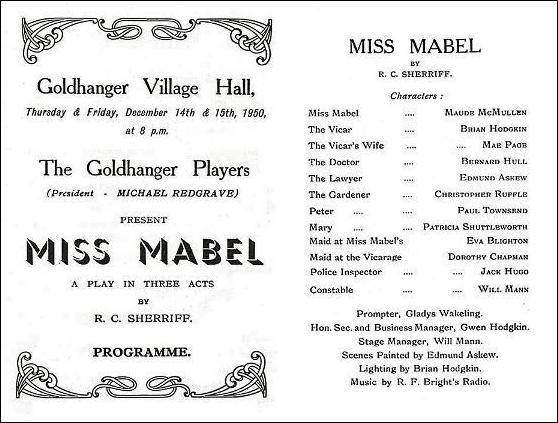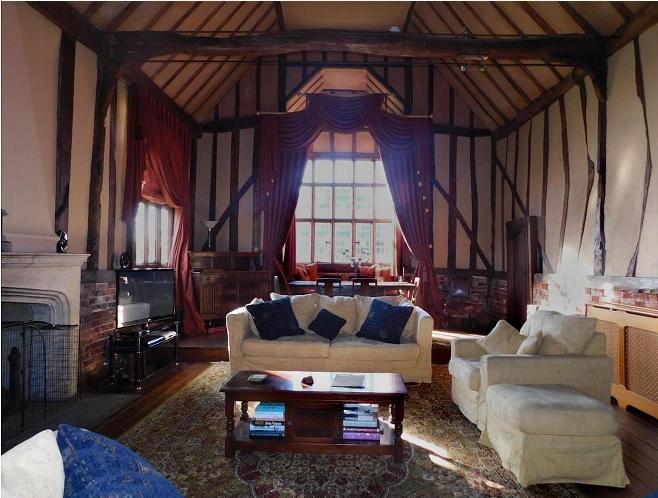Maud
and Alex McMullen, and family
Maud and
Alex McMullen lived at Follyfaunts and then
Rockleys between 1930 and the 1950s. Maud is best known locally for her
involvement with the Goldhanger Players drama group. The McMullen’s were
related to the Kempson and Redgrave families who lived
at Corner Cottage during the war, which was part of the Rockleys estate.
|
|
|
|
Alex and Maud with her mother |
Maude and Alex McMullen’s wedding in
1902 |
An extract from: Follyfaunts House, a History written by
Peter Bushell in 2002...
In November 1931 an article appeared in Architecture
Illustrated showing a conversion of the dwelling by A.L. McMullen from a Tudor
house with a Georgian front of about 1750.
The 1933 directories list the property in the
occupation of Alexander Percy McMullen C.B. M.A. At this date it was called
Follyfaunts'. The telephone number was Tolleshunt D'Arcy 27.
Alex McMullen [1875-1961] was the youngest son of
A.P. McMullen of Hertford. Born 9 October 1875, he was educated at Rugby
School, where he was a Science Exhibitioner, then at Merton College, Oxford,
where he took a First in Chemistry. On graduating he took a post as an
assistant master at Bradfield College. In 1899 he joined the teaching staff of
the Royal Naval College, Osborne, transferring the year following to the Royal
Naval College at Dartmouth where in 1906 he was appointed Head of the Science
Department. During the First World War he served as a temporary lieutenant with
the Royal Naval Volunteer Reserve aboard HMS Agincourt being present at the battle
of Jutland, where his conduct earned him a mention in despatches.
From 1917 to 1936 he was an adviser to the Royal
Navy and others on matters of naval education. He returned to Dartmouth as a
master on the outbreak of the Second World War and continued to teach there
until 1941.
He shared Follyfaunts with his wife, Catherine Maude
[d.1959] whom he had married in 1902 and by whom he had two sons. Records state
that Catherine was the 'daughter of the late L. T. Ashwell, Warlingham'.
However, local knowledge claims that Catherine was of American extraction, that
she was related to the Mellon family of bankers
Maud instituted theatrical performances and built a
music-room at Rockleys. The McMullens ultimately moved to Old Times Cottage at
Tolleshunt Major.
______________________
An extract
from: the mémoires of the late Cyril Southgate...
The Goldhanger Players were formed in the years
just before WWII and many local people were involved over the ensuing years.
Mrs Maude McMullen was president and producer of many of the productions. She
was a grand lady who loved the village and its activities. With her husband she
lived in Follyfaunts and later moved to Rockleys where they converted a barn for
social events with the help of Goldhanger builder Bernard Mann.
|
They entertained many guests, including Sir
Michael Redgrave and his wife Racheal Kempson, who was probably Mrs McMullen's niece. Their daughter Vannessa Redgrave also
stay for holidays. During the war the Kempsons lived in Corner Cottage,
Church Rd. Rachel
Kempson opening a "Bell
Fair" in the village Hall in the 1950s with Maude
McMullen behind her. The lady in
the foreground has not been identified. |
|
|
|
|
Many plays were performed in the Village Hall including Shakespeare's Twelfth
Night and The Merchant of Venice. Mrs McMullen, or Mrs Mac as she was affectionately known, loved costume
plays, and obtained beautiful costumes from London theatrical agencies
through her family contacts. The performances ran for two or three evenings
including a Saturday, after which all the cast and helpers would enjoyed a
social evening in the Rockleys Barn. |
|
During the winter months the barn would be brightly lit, there would be
a great roaring fire with logs two feet long, with much party fare provided by
the wonderful Mrs Mac and her husband. He loved to wear evening dress for these
occasions and played a beautiful grand piano, which was on a raised dais at one
end of the barn.
|
|
|
|
|
|
Rockeys Barn earlier |
Rockeys Barn recently |
The barn’s interior recently |
the bay & dais |
______________________
|
a 1948 newspaper report... |
a 1949 newspaper report... |
|
|
|

the 1950 programme for Miss Mabel - showing
Michael Redgrave as President
the cast of Miss Mabel taking a curtain call
- Maude Mc Mullen is centre stage
______________________
|
|
|
|
|
|
inscription
on the McMullen chair |
|||
|
the
McMullen chair in the Village Hall
Goldhanger Players Trophy |
|||
______________________
from Goldhanger W.I. minutes...
Mrs
McMullen - President Dec 1945 - Dec 1949
“On
many occasions a garden meeting was held at Rockleys by invitation of Mrs
McMullen”.
______________________
The Family
The McMullen family contained a large number of successful
members of the acting profession. It is difficult to establish the exact
relationship between the members of the family, but the extracts below from
several documents and websites help to identify those relatives. It seems most
likely that Rachel Kempson was Maud McMullen’s niece.

______________________
from...
“Essex”
by Nikolaus Pevsner in 1954
and James Bettley in 2007

from... www.myheritage.com/names/beatrice_kempson
Beatrice Hamilton Kempson (born
Ashwell) was born in month 1884, at birth place.
Beatrice married Eric William Edward
Kempson circa 1909, at age 24 at marriage place.
Eric was born in October 1878, in
Tupsley, Herefordshire, England.
His occupations were Teacher and
Schoolmaster R N College.
They had one daughter: Rachel Redgrave
(born Kempson).
from... en.wikipedia.org/wiki/Rachel_Kempson
Rachel Kempson was born in Dartmouth,
Devon, the daughter of Beatrice Hamilton (née Ashwell)
and Eric William Edward Kempson, a
headmaster.
 Kempson married fellow actor Michael
Redgrave in 1935,
Kempson married fellow actor Michael
Redgrave in 1935,
and became the daughter-in-law of Roy
Redgrave and Margaret Scudamore.
Rachel Kempson was the mother of:
Vanessa (born 1937), Corin (1939–2010)
and Lynn Redgrave (1943–2010)
from... https://www.imdb.com/name/nm0447499/bio
Rachel Kempson Biography
Rachel Kempson was born on 28 May,
1910, in Dartmouth, Devon, England, to Beatrice Hamilton (Ashwell) and Eric
William Edward Kempson, a headmaster.
from... www.bythedart.co.uk/about-dartmouth/famous-sons-and-daughters
On
May 28th 1910, Rachel Kempson came into the world at the family home in the
grounds of Britannia Royal Naval College. Her father, Eric, who had taught at
Rugby School and worked for the Board of Education at Kew, came to Dartmouth as
headmaster of the College. His wife, Beatrice, was known to all as Beanie, and
they had three children, Rachel and her brothers Eric, whose nickname was
Robin, and Nicholas.
______________________
extracts
from... https://ore.exeter.ac.uk/repository/bitstream/handle/10871/10701/RomansE.pdf
Selection and Early Career Education of Executive Officers in
the Royal Navy
c1902-1939
Submitted by Elinor Frances Romans, to
the University of Exeter
as a thesis for the degree of Doctor
of Philosophy in Maritime History, March 2012.
Abstract
This
thesis is concerned with the selection and early career education of executive
branch officers in the Royal Navy c1902-1939. The thesis attempts to place
naval selection and educational policy in context by demonstrating how it was
affected by changing naval requirements, external political interference and
contemporary educational reform.
Alexander McMullen
- McMullen's association with the Royal Navy began with teaching science at
Dartmouth, before serving at sea in the First World War. (His performance at
Jutland was sufficiently impressive to see him recommended for early
promotion). From 1919-1936 he served as Admiralty Advisor on Education.
McMullen's
appointment had much to recommend it beyond economy. He had been Head of
Science at Dartmouth from its opening until the outbreak of war and had then
served at sea — an attractive combination which also gave him invaluable
experience of working with ratings, the education of whom was also part of the
Admiralty Education Advisor's responsibilities.
His
brief was to give 'sound and responsible advice on the question of education'
and his responsibilities extended to all Royal Navy and Royal Marine personnel,
as well as the civilian workers educated in dockyard schools. The work was
important and McMullen's role was potentially vital. But he was hamstrung by
being a civilian employed as an advisor and therefore lacking any real power
over naval policy.
Eric Kempson
(1878-1948) - Taught at Dartmouth before the First World War, saw war service
in the Royal Engineers (winning the Military Cross) and subsequently became
Head of Science at Rugby. Kempson succeeded Ashford, becoming the headmaster of
Dartmouth in 1927, he retired in 1940.
Eric
Kempson, the Headmaster of Dartmouth, considered that although in theory open
to all, officer entry was in reality limited to boys from wealthy families. He
thought that the entrance examinations favoured prep school boys; secondary
school boys would not know enough Latin. The examinations were based on the
curricula of prep schools so little change could be made, although perhaps
French could be offered as an alternative to Latin.
______________________
from... The
Chelmsford Chronicle of August 1944:
from... The Times
Obituary column of November 1945:

______________________
top more characters from the past home









